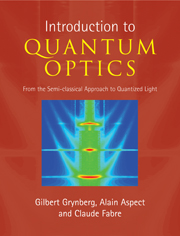Book contents
- Frontmatter
- Contents
- Foreword
- Preface
- Acknowledgements
- Part I Semi-classical description of matterlight interaction
- Part II Quantum description of light and its interaction with matter
- 4 Quantization of free radiation
- Complement 4A: Example of the classical Hamiltonian formalism: charged particle in an electromagnetic field
- Complement 4B: Momentum and angular momentum of radiation
- Complement 4C: Photons in modes other than travelling plane waves
- 5 Free quantum radiation
- Complement 5A: Squeezed states of light: the reduction of quantum fluctuations
- Complement 5B: One-photon wave packet
- Complement 5C: Polarization-entangled photons and violation of Bell's inequalities
- Complement 5D: Entangled two-mode states
- Complement 5E: Quantum information
- 6 Interaction of an atom with the quantized electromagnetic field
- Complement 6A: Hamiltonian formalism for interacting fields and charges
- Complement 6B: Cavity quantum electrodynamics
- Complement 6C: Polarization-entangled photon pairs emitted in an atomic radiative cascade
- Part III Applying both approaches
- Index
4 - Quantization of free radiation
Published online by Cambridge University Press: 05 August 2012
- Frontmatter
- Contents
- Foreword
- Preface
- Acknowledgements
- Part I Semi-classical description of matterlight interaction
- Part II Quantum description of light and its interaction with matter
- 4 Quantization of free radiation
- Complement 4A: Example of the classical Hamiltonian formalism: charged particle in an electromagnetic field
- Complement 4B: Momentum and angular momentum of radiation
- Complement 4C: Photons in modes other than travelling plane waves
- 5 Free quantum radiation
- Complement 5A: Squeezed states of light: the reduction of quantum fluctuations
- Complement 5B: One-photon wave packet
- Complement 5C: Polarization-entangled photons and violation of Bell's inequalities
- Complement 5D: Entangled two-mode states
- Complement 5E: Quantum information
- 6 Interaction of an atom with the quantized electromagnetic field
- Complement 6A: Hamiltonian formalism for interacting fields and charges
- Complement 6B: Cavity quantum electrodynamics
- Complement 6C: Polarization-entangled photon pairs emitted in an atomic radiative cascade
- Part III Applying both approaches
- Index
Summary
Many processes, including absorption and stimulated emission occurring in lasers, can be handled using a semi-classical model for the atom–radiation interaction, in which the matter is given a quantum description, but the radiation is represented as a classical electromagnetic field (see Chapter 2). There are other phenomena that cannot be adequately described without quantizing the radiation. For example, it has been known since the 1930s that spontaneous emission can only be treated correctly using a fully quantum framework for the interaction, in which both the matter and the radiation are quantized, as we shall see in Chapter 6.
However, it was not until the 1970s that situations were found in which a free electromagnetic field, far from sources, exhibited properties and behaviour that could not be described by a classical field, but which could be perfectly well interpreted in terms of a quantized field. This chapter is devoted to the quantization of the free electromagnetic field, far from the charges and currents sourcing it. This free electromagnetic field will be called radiation, and in Chapter 6 we shall specify exactly what is meant by radiation when sources are present.
The canonical quantization procedure used here starts from a description of the classical dynamics of the field in the framework of the Hamiltonian formalism, the basic features of which are discussed in Section 4.1.
- Type
- Chapter
- Information
- Introduction to Quantum OpticsFrom the Semi-classical Approach to Quantized Light, pp. 301 - 324Publisher: Cambridge University PressPrint publication year: 2010



